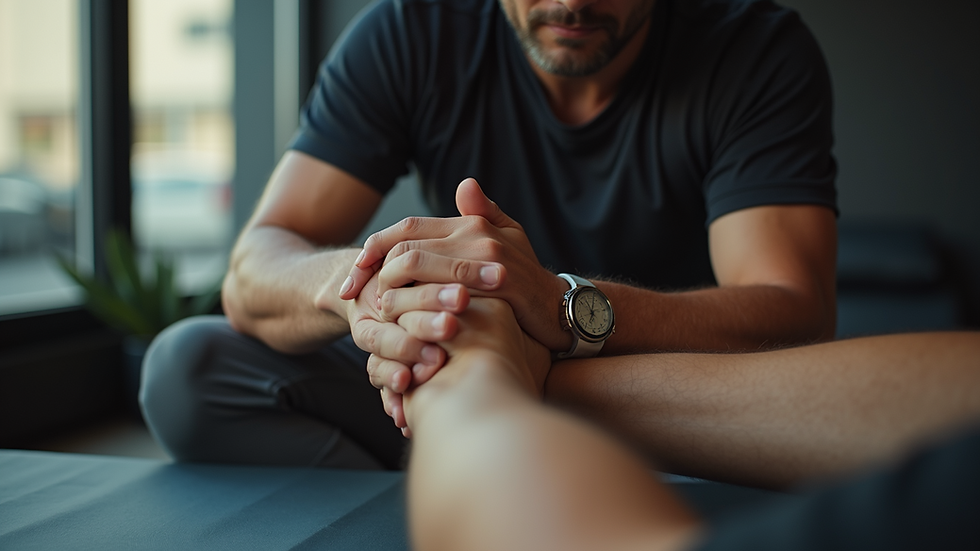Behind the Lens: Jiu Jitsu and MMA Video Techniques
- michaeldanielcampb
- Sep 5
- 4 min read
In the world of martial arts, the visual aspect plays a crucial role. Whether you are a seasoned practitioner or a curious beginner, understanding the techniques through video can enhance your learning experience. This blog post will explore the art of capturing Jiu Jitsu and MMA techniques on video. We will discuss the importance of video analysis, the best practices for filming, and how to effectively use these videos for training.
The Importance of Video Analysis
Video analysis is a powerful tool in martial arts training. It allows practitioners to see their techniques from a different perspective. Watching yourself or others perform can reveal details that you might miss during live practice.
Benefits of Video Analysis
Self-Reflection: Watching your own performance helps identify strengths and weaknesses. You can see what works and what needs improvement.
Learning from Others: Analyzing videos of skilled practitioners can provide insights into advanced techniques. You can learn new moves and strategies by observing their execution.
Progress Tracking: Recording your training sessions allows you to track your progress over time. You can compare your earlier videos with recent ones to see how much you have improved.
Best Practices for Filming Techniques
When it comes to filming Jiu Jitsu and MMA techniques, there are several best practices to keep in mind. These tips will help you create high-quality videos that are useful for analysis and learning.
Choose the Right Angle
The camera angle can significantly affect how techniques are perceived. Here are some recommended angles:
Eye-Level View: This angle provides a clear view of the techniques as they are performed. It allows viewers to see the movements as if they were right there on the mat.
High Angle View: This perspective is great for showcasing the overall flow of a technique. It helps viewers understand the spatial relationships between practitioners.
Close-Up Shots: Use close-ups to highlight specific details, such as grips or foot placement. This can be particularly useful for complex techniques.
Ensure Good Lighting
Lighting is essential for clear video quality. Here are some tips for achieving good lighting:
Natural Light: If possible, film during the day when natural light is abundant. This will help reduce shadows and improve visibility.
Avoid Backlighting: Make sure the light source is in front of the camera, not behind it. Backlighting can create silhouettes that obscure details.
Use Additional Lights: If filming indoors, consider using softbox lights or ring lights to enhance visibility.
Keep the Camera Steady
A shaky camera can make it difficult to follow techniques. Here are some ways to keep your camera steady:
Use a Tripod: A tripod will provide stability and allow you to focus on the action without worrying about holding the camera.
Practice Panning: If you need to follow the action, practice smooth panning movements. Avoid quick jerks that can distract viewers.
Editing Your Videos
Once you have filmed your techniques, the next step is editing. Editing can enhance the quality of your videos and make them more engaging.
Basic Editing Techniques
Cut Unnecessary Footage: Trim any parts of the video that do not contribute to the learning experience. Keep the focus on the techniques.
Add Annotations: Use text overlays to highlight key points or explain specific techniques. This can help viewers understand the context better.
Slow Motion: Consider using slow-motion effects for complex techniques. This allows viewers to see the details more clearly.
Sharing Your Videos
After editing, it is time to share your videos. Here are some platforms to consider:
YouTube: A popular platform for sharing martial arts videos. You can reach a wide audience and receive feedback from viewers.
Social Media: Platforms like Instagram and Facebook are great for sharing short clips. Use hashtags to reach fellow practitioners.
Private Groups: If you prefer a more controlled audience, consider sharing videos in private groups or forums dedicated to martial arts.
Using Videos for Training
Now that you have your videos, how can you use them effectively for training? Here are some strategies to maximize their impact.
Review and Reflect
Set aside time to watch your videos regularly. Take notes on what you observe. Reflect on your performance and identify areas for improvement.
Share with Training Partners
Share your videos with training partners or coaches. They can provide valuable feedback and help you see things from a different perspective.
Create a Video Library
Build a library of videos that showcase various techniques. Organize them by skill level or technique type. This will make it easier to find specific content when you need it.
Real-Life Examples
To illustrate the effectiveness of video analysis, let’s look at a few real-life examples.
Example 1: The Armbar
A practitioner filmed themselves performing an armbar from guard. After reviewing the video, they noticed their grip was too loose. They adjusted their technique and filmed it again. The second video showed a significant improvement in execution.
Example 2: Sparring Sessions
A group of friends recorded their sparring sessions. They later watched the footage together and discussed strategies. This collaborative approach helped them learn from each other and improve their overall game.
The Future of Video in Martial Arts
As technology continues to evolve, the role of video in martial arts training will only grow. Here are some trends to watch for in the future.
Virtual Reality Training
Virtual reality (VR) is becoming more accessible. Imagine being able to practice techniques in a virtual environment. This could revolutionize how practitioners learn and train.
Advanced Analytics
With the rise of artificial intelligence, we may see advanced analytics tools that can analyze techniques in real-time. This could provide instant feedback and help practitioners refine their skills.
Online Training Platforms
Online training platforms are gaining popularity. These platforms often include video analysis features, allowing practitioners to receive feedback from coaches remotely.
Final Thoughts
Capturing Jiu Jitsu and MMA techniques on video is more than just recording. It is about enhancing your learning experience and improving your skills. By understanding the importance of video analysis, following best practices for filming, and effectively using your videos for training, you can take your martial arts journey to the next level.
Embrace the power of video, and let it guide you on your path to mastery. Whether you are filming yourself or analyzing others, remember that every frame is an opportunity to learn and grow. So grab your camera, hit the mat, and start capturing those techniques today!




Comments